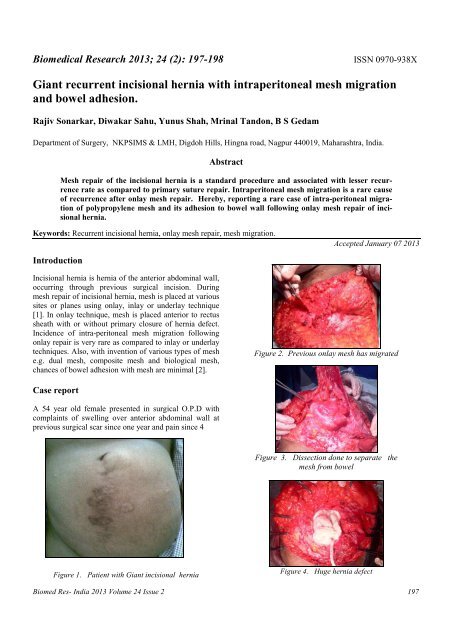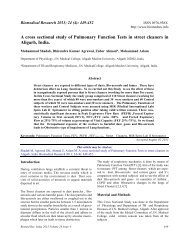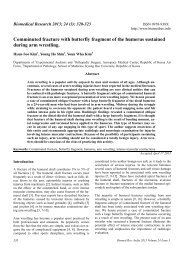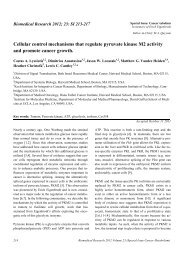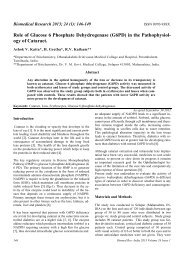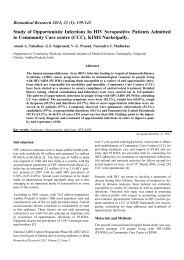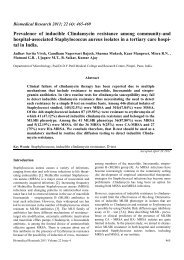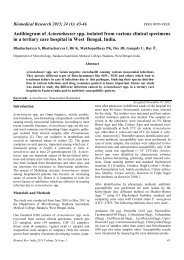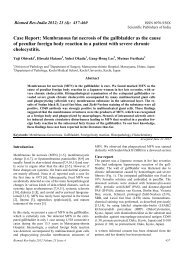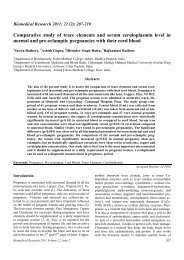Giant recurrent incisional hernia with intraperitoneal mesh migration ...
Giant recurrent incisional hernia with intraperitoneal mesh migration ...
Giant recurrent incisional hernia with intraperitoneal mesh migration ...
You also want an ePaper? Increase the reach of your titles
YUMPU automatically turns print PDFs into web optimized ePapers that Google loves.
Biomedical Research 2013; 24 (2): 197-198 ISSN 0970-938X<br />
<strong>Giant</strong> <strong>recurrent</strong> <strong>incisional</strong> <strong>hernia</strong> <strong>with</strong> <strong>intraperitoneal</strong> <strong>mesh</strong> <strong>migration</strong><br />
and bowel adhesion.<br />
Rajiv Sonarkar, Diwakar Sahu, Yunus Shah, Mrinal Tandon, B S Gedam<br />
Department of Surgery, NKPSIMS & LMH, Digdoh Hills, Hingna road, Nagpur 440019, Maharashtra, India.<br />
Abstract<br />
Mesh repair of the <strong>incisional</strong> <strong>hernia</strong> is a standard procedure and associated <strong>with</strong> lesser recurrence<br />
rate as compared to primary suture repair. Intraperitoneal <strong>mesh</strong> <strong>migration</strong> is a rare cause<br />
of recurrence after onlay <strong>mesh</strong> repair. Hereby, reporting a rare case of intra-peritoneal <strong>migration</strong><br />
of polypropylene <strong>mesh</strong> and its adhesion to bowel wall following onlay <strong>mesh</strong> repair of <strong>incisional</strong><br />
<strong>hernia</strong>.<br />
Keywords: Recurrent <strong>incisional</strong> <strong>hernia</strong>, onlay <strong>mesh</strong> repair, <strong>mesh</strong> <strong>migration</strong>.<br />
Accepted January 07 2013<br />
Introduction<br />
Incisional <strong>hernia</strong> is <strong>hernia</strong> of the anterior abdominal wall,<br />
occurring through previous surgical incision. During<br />
<strong>mesh</strong> repair of <strong>incisional</strong> <strong>hernia</strong>, <strong>mesh</strong> is placed at various<br />
sites or planes using onlay, inlay or underlay technique<br />
[1]. In onlay technique, <strong>mesh</strong> is placed anterior to rectus<br />
sheath <strong>with</strong> or <strong>with</strong>out primary closure of <strong>hernia</strong> defect.<br />
Incidence of intra-peritoneal <strong>mesh</strong> <strong>migration</strong> following<br />
onlay repair is very rare as compared to inlay or underlay<br />
techniques. Also, <strong>with</strong> invention of various types of <strong>mesh</strong><br />
e.g. dual <strong>mesh</strong>, composite <strong>mesh</strong> and biological <strong>mesh</strong>,<br />
chances of bowel adhesion <strong>with</strong> <strong>mesh</strong> are minimal [2].<br />
Figure 2. Previous onlay <strong>mesh</strong> has migrated<br />
Case report<br />
A 54 year old female presented in surgical O.P.D <strong>with</strong><br />
complaints of swelling over anterior abdominal wall at<br />
previous surgical scar since one year and pain since 4<br />
Figure 3. Dissection done to separate the<br />
<strong>mesh</strong> from bowel<br />
Figure 1. Patient <strong>with</strong> <strong>Giant</strong> <strong>incisional</strong> <strong>hernia</strong><br />
Figure 4. Huge <strong>hernia</strong> defect<br />
Biomed Res- India 2013 Volume 24 Issue 2 197
Sonarkar/Sahu/Gedam/Tandon<br />
months. In her surgical history, she had undergone laparotomy<br />
through infra-umblical midline incision 8 years back<br />
for appendicular perforation following which she developed<br />
<strong>incisional</strong> <strong>hernia</strong> after five years. Patient was operated<br />
for <strong>incisional</strong> <strong>hernia</strong> and onlay <strong>mesh</strong> repair was done<br />
after closure of midline <strong>hernia</strong> defect <strong>with</strong> polypropylene<br />
suture. Three years after this surgery, patient developed<br />
recurrence of the <strong>incisional</strong> <strong>hernia</strong>.<br />
Patient was then operated in our institution and during<br />
surgery it was found that a <strong>hernia</strong>l sac was present occupying<br />
left lower quadrant of abdominal wall and <strong>mesh</strong><br />
was displaced to the right side <strong>with</strong> polypropylene suture<br />
of previous surgery. On further dissection it was discovered<br />
that <strong>mesh</strong> has got migrated to peritoneal cavity in the<br />
midline region and was densely adhered to ileum at two<br />
sites. Bowel was then freed from <strong>mesh</strong> which resulted in<br />
serosal tear, which was repaired later and previous <strong>mesh</strong><br />
was completely removed. Hernial sac then opened, adhesion<br />
between omentum, bowel and sac was separated and<br />
<strong>hernia</strong>l content reduced to peritoneal cavity. Then <strong>hernia</strong><br />
defect <strong>with</strong> sutured peritoneum, which was 12cm x 8cm,<br />
was repaired <strong>with</strong> polypropylene <strong>mesh</strong>. Mesh was laid<br />
between musculo-aponeurotic layer and subcutaneous fat<br />
and overlapped beyond the defect margin for about 4cm<br />
and sutured <strong>with</strong> polypropylene. Suction drain was kept<br />
and wound closed in layers. Postoperative period was<br />
uneventful and patient recovered <strong>with</strong>out any complications.<br />
Discussion<br />
Hernias are among the oldest known affliction of humankind<br />
and surgical repair of <strong>hernia</strong> is among the most<br />
common general surgery procedure performed today. Despite<br />
of various competent methods, technical aspects of<br />
<strong>hernia</strong> repair continue to evolve [2].<br />
In 1958 Usher et al developed polypropylene <strong>mesh</strong>, Marlex,<br />
and used it in large <strong>hernia</strong> repair. The use of <strong>mesh</strong><br />
significantly reduced the incidence of recurrence following<br />
repair. However, this is not <strong>with</strong>out complication, the<br />
most common being infection and <strong>migration</strong> of <strong>mesh</strong> [1,<br />
3]. With use of presently available dual <strong>mesh</strong>, made up of<br />
expanded PTFE <strong>with</strong> impregnated silver carbonate and<br />
chlorhexidine and composite <strong>mesh</strong> which is made up of<br />
more than one type of material, incidence of bowel erosion<br />
and <strong>mesh</strong> <strong>migration</strong> have reduced [1].<br />
Our case illustrates certain important points. The literature<br />
reports very few cases of <strong>mesh</strong> <strong>migration</strong> and visceral<br />
erosion and that to after underlay or pre-peritonial <strong>mesh</strong><br />
repair [4, 5]. This case clearly demonstrates that <strong>mesh</strong><br />
<strong>migration</strong> can occur even after onlay or overlay <strong>mesh</strong> repair.<br />
We feel that above mentioned complication in our case<br />
was probably due to repair of <strong>hernia</strong> defect under tension<br />
before laying onlay <strong>mesh</strong> during previous surgery. This<br />
might have resulted in cut through and give away of suture.<br />
Furthermore, improper placement of stay sutures, to<br />
keep the <strong>mesh</strong> in place, would have lead to <strong>mesh</strong> <strong>migration</strong><br />
[6, 7]. Lastly, anatomically the rectus sheath is deficient<br />
posteriorly below the arcuate line and hence, after<br />
repair there is no fascial layer between the <strong>mesh</strong> and bowel,<br />
thereby predisposing to <strong>mesh</strong> <strong>migration</strong>.<br />
Hence, we recommend that <strong>incisional</strong> <strong>hernia</strong> repair should<br />
be totally tension free, <strong>mesh</strong> should be anchored to fascial<br />
or musculoaponeurotic layer adequately <strong>with</strong> nonabsorbable<br />
suture and lastly, there must be some tissue<br />
layer in form of omentum or peritoneum between abdominal<br />
viscera and <strong>mesh</strong>.<br />
References<br />
1. Andrew G. Harrell, Yuri W. Novitsky. Shakelfords<br />
Surgery of the alimentary tract. Sixth edition; Saunders.<br />
Vol. 1.p.671-687.<br />
2. Patrick J. Javid PJ, David C. Brooks. Maingot’s Abdominal<br />
Operations. Eleventh edition; Mc Graw Hills.<br />
Vol.1 p.133-137.<br />
3. Graziano - M. Santangelo et al. Mesh erosion into the<br />
bladder: complication by <strong>hernia</strong> repair. Acta Chirurgica<br />
Mediterranea, 2007, 23:p.127-128.<br />
4. E. C. Nelson and T. J. Vidovszky. Composite <strong>mesh</strong><br />
<strong>migration</strong> into the sigmoid colon following ventral <strong>hernia</strong><br />
repair. Hernia. 2011 February; 15(1):p.101-103.<br />
5. Steinhagen E, Khaitov S, Steinhagen R M. Intraluminal<br />
<strong>migration</strong> of <strong>mesh</strong> following <strong>incisional</strong> <strong>hernia</strong> repair.<br />
Hernia: the journal of <strong>hernia</strong>s and abdominal wall surgery.<br />
2010 Dec; 14(6):p.659-662.<br />
6. De Santis L, Frigo F, Bruttocao A, Terranova O.<br />
Pathophysiology of giant <strong>incisional</strong> <strong>hernia</strong>s <strong>with</strong> loss of<br />
abdominal wall substance. Acta Biomed. 2003;74<br />
Suppl 2: 34-37. (Pubmed).<br />
7. Pailler JL, Lalchel-le Coadou A, Dupont-Bierre E. Incisional<br />
<strong>hernia</strong> of the anterior abdominal wall. Pathophysiology,<br />
etiology and prosthetic repair techniques.<br />
Ann Chir Plast Esthet. 1999 Aug;44(4):p.313-<br />
324.(Pubmed)<br />
Correspondence to:<br />
Diwakar Sahu<br />
Department of Surgery<br />
NKPSIMS & LMH, Digdoh Hills, Hingna Road<br />
Nagpur 440019<br />
Maharashtra, India<br />
198 Biomed Res- India 2013 Volume 24 Issue 2


